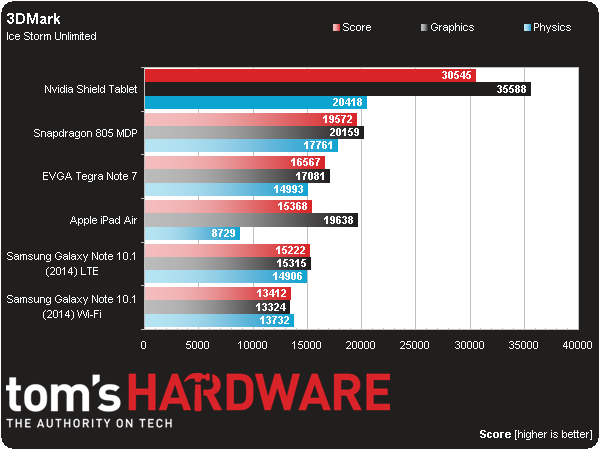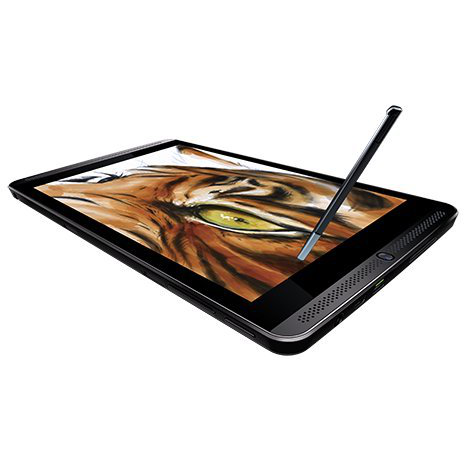Nvidia Shield Tablet And Shield Controller Review
The Shield Tablet, powered by Nvidia’s Tegra K1 SoC, deftly handles browsing and media playback duties. Combining it with the wireless Shield Controller transforms the 8-inch device into an exciting mobile gaming platform.
Results: GPU Core Benchmarks
3DMark (Anti-Detection)
Futuremark has become a name synonymous with benchmarking, and the company's latest iteration of 3DMark offers three main graphical benchmarks: Ice Storm, Cloud Gate and Fire Strike. Currently, the DirectX 9-level Ice Storm tests are cross-platform for Windows, Windows RT, Android and iOS.
Ice Storm simulates the demands of OpenGL ES 2.0 games using shaders, particles and physics via the company's in-house engine. Although it was just released in May of 2013, the on-screen portions of Ice Storm have already been outpaced by modern mobile chipsets, with Nvidia's Tegra 4 and Qualcomm's Snapdragon 800 both easily maxing-out the Extreme version (1080p with high-quality textures). However, Ice Storm Unlimited, which renders the scene off-screen at 720p, is still a good gauge of GPU-to-GPU performance.
GPU performance expectations are high for Nvidia’s Tegra K1 and it doesn’t disappoint, posting the highest Physics and Graphics scores. Its final score is 1.56x better than the Adreno 420 in Snapdragon 805. Looking only at the Graphics test, the Tegra K1 puts its 192 CUDA cores to good use, outscoring the Adreno 420 and PowerVR G6430 by a factor of about 1.77x. If this result is typical, Qualcomm and Imagination will need to work hard to match Kepler’s performance.
Basemark X 1.1
Based on the Unity 4.0 game engine, Rightware’s Basemark X is a cross-platform graphics benchmark for Android, iOS, and Windows Phone 8. This test utilizes Unity’s modern features via the OpenGL ES 2.0 render path to simulate how a game might look and run. Basemark X is an aggressive test that still hasn’t been maxed out by the latest mobile SoCs.
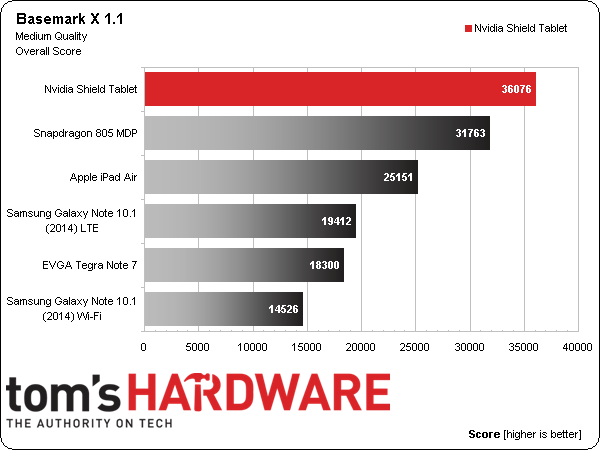

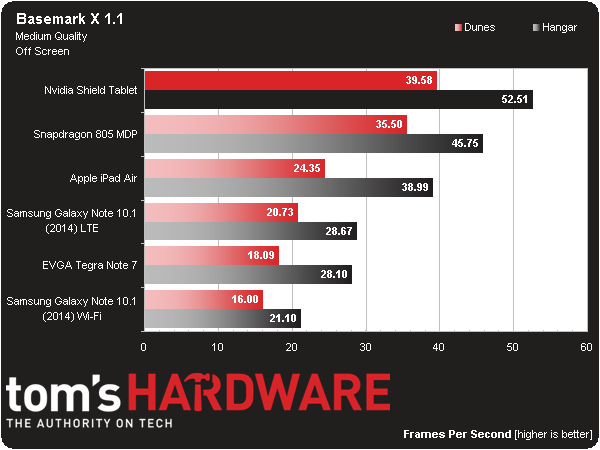
Tegra K1’s margin of victory over the Adreno 420 at Medium Quality is only 14%, but it's almost twice as fast as the Tegra 4 in Nvidia’s previous tablet offering. Not a bad performance gain in just one generation!
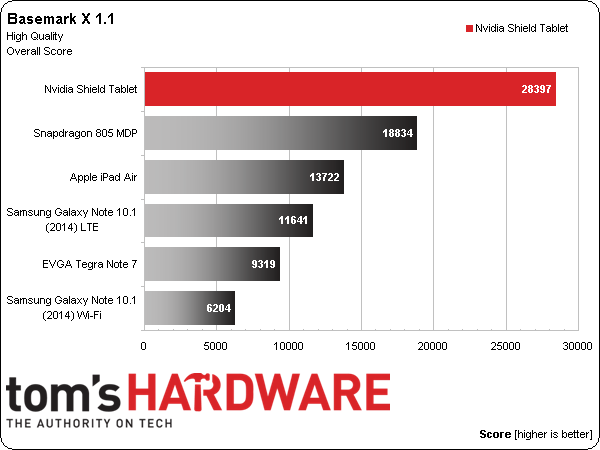
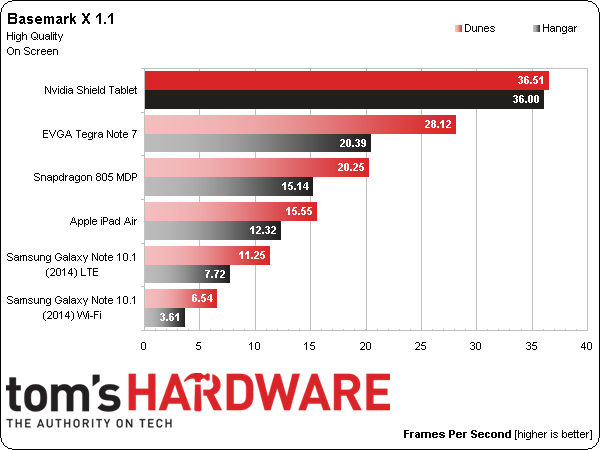
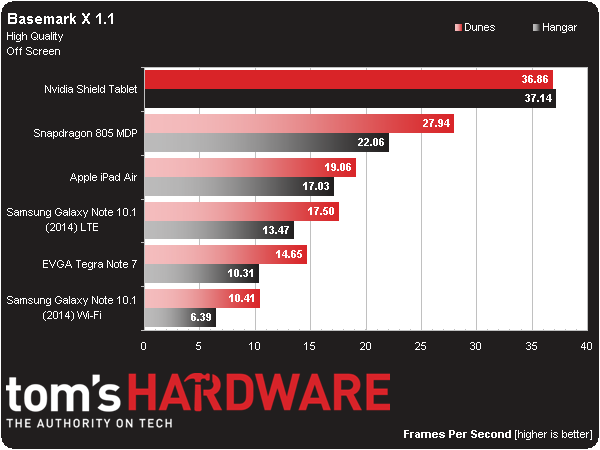
The finishing order is unchanged at the higher quality setting, but Tegra K1’s lead increases to 51% over the Adreno 420. It also leaves the iPad Air looking a bit deflated, besting it by a factor of two.
GFXBench 3.0 Corporate
Kishonti GFXBench 3.0 is a cross-platform GPU benchmark supporting both the OpenGL ES 2.0 and OpenGL ES 3.0 APIs. It comprises both “high-level” game-like scenarios, along with more “low-level” tests designed to measure specific subsystems.
Get Tom's Hardware's best news and in-depth reviews, straight to your inbox.
Among the high-level tests are Manhattan and T-Rex. Manhattan is a modern, complex OpenGL ES 3.0-based test, while the OpenGL ES 2.0-level T-Rex is a holdover from GFXBench v2.7.
The low-level tests include Fill, which measures fill rate by rendering four layers of compressed textures; Alpha Blending, a test that renders layers of semi-transparent quads using high-resolution, uncompressed textures; ALU, for measuring shader compute performance and Driver Overhead, which measures the CPU overhead of the graphics driver and API by making a lot of draw calls and state changes.
See GFXBench 3.0: A Fresh Look At Mobile Benchmarking for a complete test-by-test breakdown of this benchmark.
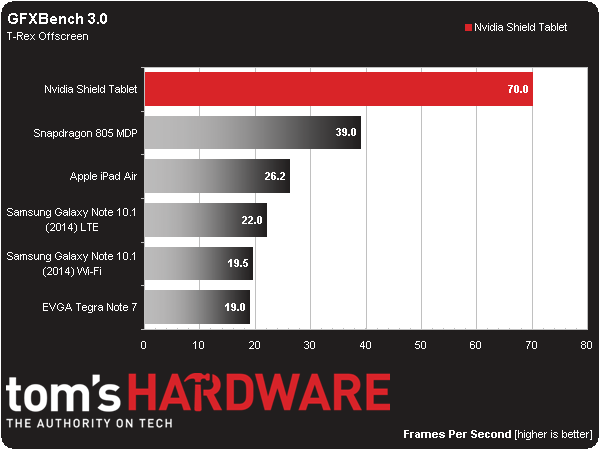

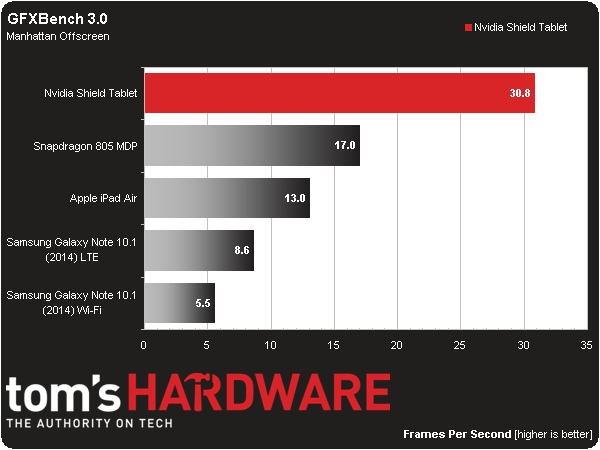
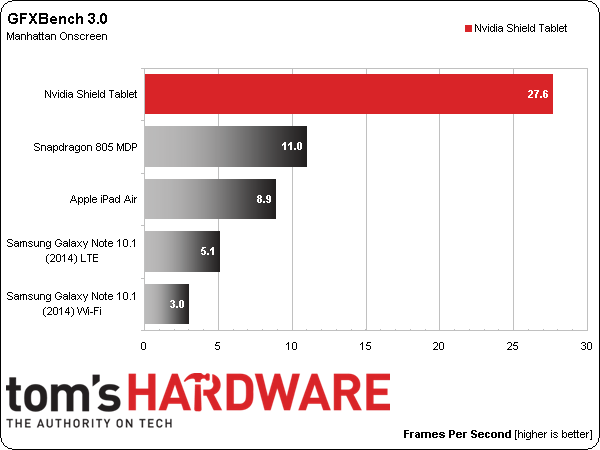
The Shield Tablet looks particularly impressive running T-Rex. In Offscreen rendering, it’s 1.8x faster than the Snapdragon 805 reference tablet and a staggering 2.7x faster than the iPad Air. It also has no problem running T-Rex smoothly at the screen’s native resolution.
The Shield Tablet maintains nearly the same advantage over its closest two competitors in the more demanding Manhattan benchmark and almost breaks the 30FPS barrier rendering at its native screen resolution.
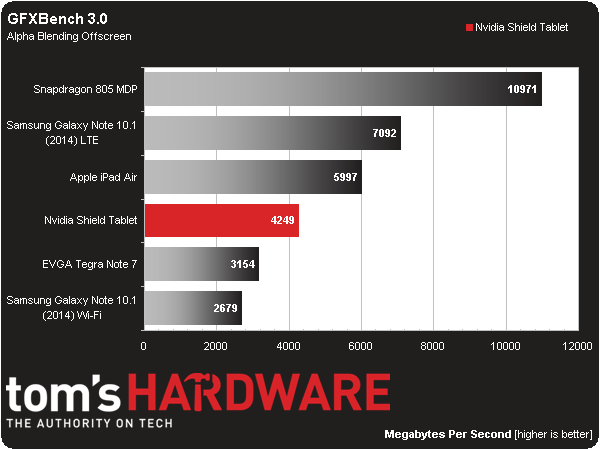


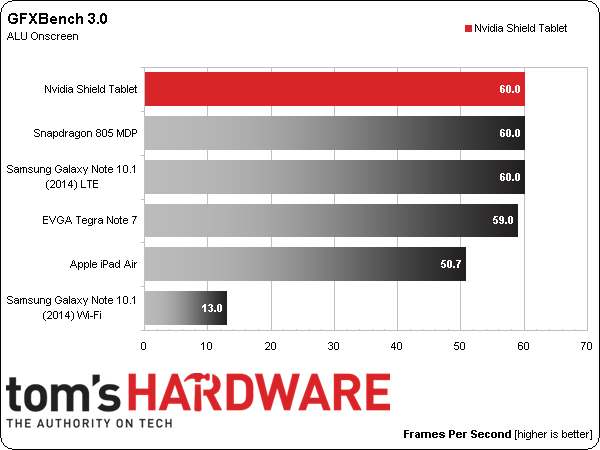
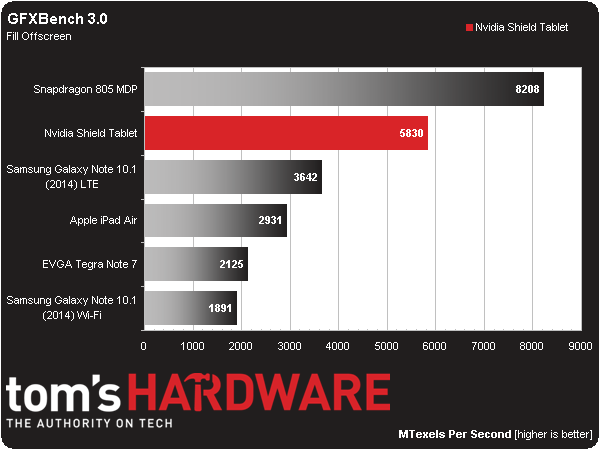
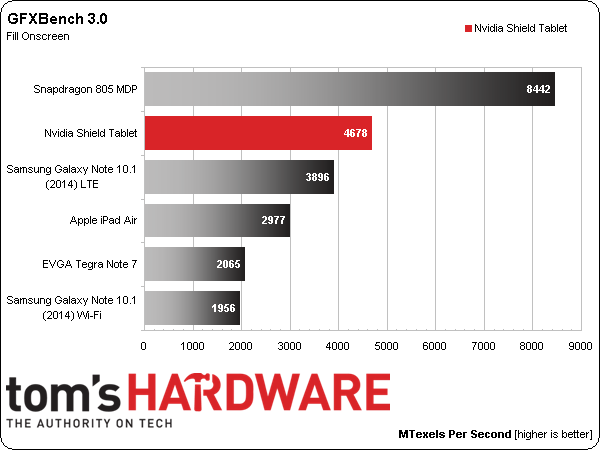
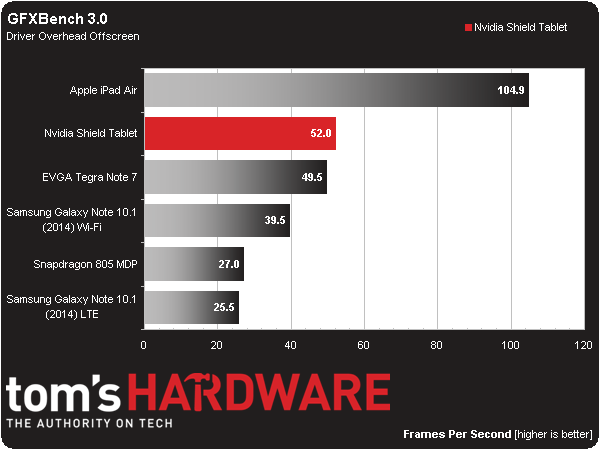


The Alpha Blending test shows the two Adreno GPUs out front and an uncharacteristic drop-off in performance for Tegra K1. It’s Achilles heel may be memory bandwidth since it doesn’t seem to handle the high-resolution, uncompressed textures used in this test very well.
Tegra K1’s 1.8x advantage reappears in the compute-intensive ALU test. Shader performance is definitely Kepler’s strength.
Snapdragon 805 wins the Fill test with its superior memory bandwidth. Tegra K1 falls to second place, but still offers twice the Fill performance as Apple’s A7.
Graphics performance is the biggest test for a gaming device, and the Shield Tablet passes with flying colors. Nvidia’s Tegra K1 is at the head of the mobile GPU class, busting the curve that all other SoCs are graded on.
Current page: Results: GPU Core Benchmarks
Prev Page Results: HTML5 And JavaScript Benchmarks Next Page Results: GPGPU Benchmarks-
blubbey Those GPGPU benchmarks are ridiculous in comparison. It looks like a great bit of kit from what I've seen so far. A die shrunk Maxwell should be fantastic. Maybe even a lower clocked version just for power consumption? It'll still perform as well, if not better than the K1 at 750MHz (assuming 2 SMMs) I'd assume.Reply -
Memnarchon "Based on these results, Tegra K1 must be “a neural net processor; a learning computer” sent back through time to destroy all of the other SoCs that could lead a rebellion in the post-apocalyptic future."Reply
Lol this is epic! xD
Anyway, great and unique review. Especially for the so many GPGPU benchmarks.
Nvidia tablet at $299 seems to be a great buy. -
aberkae If maxwell brings double the performance per watt on the same node the next tegra chip on 20 nm node should be a home run for the companyReply -
deftonian Impressive, but I feel it's still missing that "umph" to get me to buy this and carry it around as an added device, next to my phone (Note 3). Maybe I just don't game enough on the android market or steam. Either way, I think it is impressive for a mobile gaming device and all the things it offers. I think they've started a great line and hope it grows into a successful tablet/gaming brand.Reply -
aberkae If maxwell brings double the performance per watt on the same node the next tegra chip on 20 nm node should be a home run for the companyReply -
gio2vanni86 The streaming a game while i'm at my friends house using my PC at home is what has me very interested. Plug into his TV and play amazing games he can only dream of. I'm in.Reply -
vithrell Just wait for Intel's Core M. It wont match the price (CPU alone will cost $300), but in fanless tablet form factor it wont have worthy competitor. Early GPU benchmarks give Core M 55k graphics score in Ice Storm, so more than 1.5x more power than Tegra K1. AND you can run full Windows on it. I wish Nvidia took x86 path with its cpu cores.Reply
